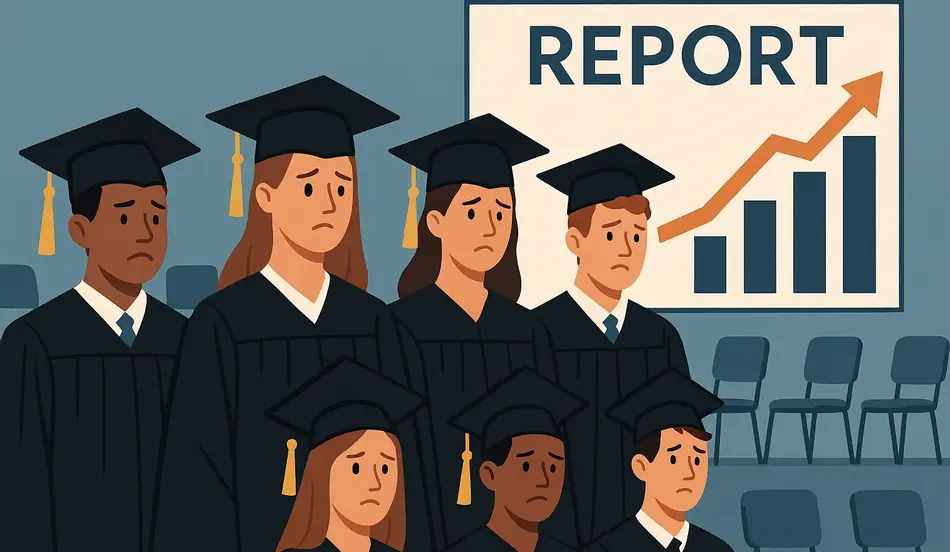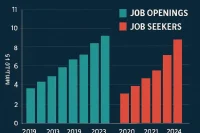The Deceptive Job Market Reality: How Official Numbers Hide a Growing Employment Crisis
In what might be the most deceptive job market in decades, recent headlines trumpet “impressive” employment figures while concealing a harsh reality for job seekers. While official reports celebrate 147,000 new jobs and a 4.1% unemployment rate, a closer examination reveals a troubling disconnect between government statistics and the actual experiences of Americans searching for work.
The truth? We’re witnessing an unprecedented employment crisis, particularly for recent graduates and career-changers, that’s being masked by misleading metrics and selective reporting. This comprehensive analysis exposes what mainstream coverage isn’t telling you about today’s bifurcated job market.
The Alarming Numbers Behind the Headlines
Recent data paints a disturbing picture that contradicts the rosy employment narrative:
- For the first time in U.S. history, unemployment for college graduates aged 22-27 (7.1%) exceeds the national average (4.1%)
- Entry-level job postings have plummeted 11.2% since 2021
- Demand for entry-level positions has dropped 50% since early 2022
- Labor force participation rate has fallen to 62.3%, the lowest since late 2022
- 329,000 people abandoned their job search entirely in the most recent reporting period
- Continuing unemployment claims have reached their highest levels since 2021
These statistics reveal what many job seekers already know firsthand: finding employment has become extraordinarily difficult despite supposedly “strong” economic indicators.
The Hollow Jobs Report: Understanding the Statistical Manipulation
Where Are These “New Jobs” Actually Coming From?
When we examine the much-celebrated job creation numbers, a concerning pattern emerges. Of the 147,000 jobs added in the most recent report:
- 85% came from just two sectors: education and healthcare
- State and local governments added 80,000 jobs (64,000 in education alone)
- Private sector hiring contributed a mere 74,000 positions
This concentration in public sector and healthcare hiring masks widespread hiring freezes across most industries. The economy isn’t broadly creating opportunities—it’s experiencing isolated growth in specific sectors while the rest remains stagnant.
How Unemployment Statistics Mislead the Public
The declining unemployment rate (4.1%) appears positive until you understand how these figures are calculated. When discouraged job seekers stop actively looking for work, they’re no longer counted as “unemployed” in official statistics—they simply disappear from the data.
This statistical sleight of hand creates the illusion of improvement while concealing a growing crisis of disengagement. The 329,000 people who recently stopped searching for work aren’t counted in unemployment figures, artificially deflating the rate and creating a false impression of economic health.
The AI and Automation Revolution: Entry-Level Jobs Vanishing
The Technological Disruption of Career Pathways
A fundamental restructuring of the job market is underway, with artificial intelligence and automation eliminating traditional entry points to professional careers:
- More than half of entry-level positions now require technical degrees or specialized digital expertise
- LinkedIn reports entry-level hiring has fallen 23% compared to March 2020
- Companies increasingly use AI to handle tasks previously assigned to junior employees
- 62% of 2025 graduates express concerns about AI’s impact on their job prospects
This technological disruption has created a paradoxical requirement for “experienced beginners”—employers demand years of specialized experience for positions traditionally designed for those starting their careers.
The Experience Trap: No Job Without Experience, No Experience Without a Job
Today’s job seekers face an impossible catch-22: companies require experience for entry-level positions, but provide few opportunities to gain that experience. This creates a devastating cycle:
- Graduates apply for entry-level positions requiring experience they couldn’t possibly have
- Applications are rejected due to lack of experience
- Without entry-level opportunities, gaining relevant experience becomes impossible
- The cycle continues, leaving qualified candidates perpetually unemployed
As one frustrated job seeker with both undergraduate and graduate degrees lamented: “I’ve applied to over 50 jobs… I have research experience, work experience of over four years… I tailor my resume, include cover letters even when not required… and I still get rejected.”
The Application Abyss: Why Job Seekers Feel Defeated
The Broken Hiring Process
The modern job application process has become increasingly dehumanized and ineffective:
- Candidates report applying to hundreds or thousands of positions without response
- Interview processes have expanded to 6-9 rounds, often ending without closure
- Assessments, personality tests, and unpaid “sample work” have become standard requirements
- Automated screening systems reject qualified candidates before human review
This dysfunctional system leaves applicants feeling like they’re “buying lottery tickets” rather than participating in a meaningful hiring process. The psychological toll is substantial, with many describing a sense of “giving away a piece of their soul” with each futile application.
The Data Mining Conspiracy: Are Job Boards Actually Hiring?
A troubling theory gaining traction suggests some job listings may exist primarily to harvest applicant data rather than fill positions. Investigations have found:
- Numerous listings that generate no callbacks despite hundreds of applications
- Companies collecting sensitive personal information through application processes
- Potential monetization of applicant data through third-party sales
While not all job boards engage in such practices, the proliferation of “ghost” listings adds another layer of frustration to an already challenging process.
The Federal Workforce Massacre: Government Cuts Amplifying the Crisis
Trump Administration’s Impact on Employment
Recent federal workforce reductions have sent shockwaves through the job market:
- Over 275,000 federal workers targeted for layoffs or furloughs
- Department of Health and Human Services fired 5,200 probationary employees
- IRS laid off 6,000-7,000 workers during peak tax season
- Department of Veterans Affairs dismissed over 1,000 employees with plans to cut 30,000 by September
These cuts don’t just affect government employees—they create ripple effects throughout the economy, reducing consumer spending, increasing competition for remaining positions, and eliminating valuable training opportunities for young professionals.
Private Sector Following Suit
The private sector has mirrored this downsizing trend:
- Microsoft cut 9,000 employees in July after already laying off 15,000 earlier this year
- 140 tech companies have laid off a total of 63,000 workers in the first half of 2025
- Major employers like Google, Starbucks, Amazon, Chevron, UPS, and CVS have announced significant workforce reductions
- Chevron plans to cut 20% of their global workforce by the end of 2026
These widespread layoffs create a hyper-competitive environment where experienced professionals displaced from career positions compete directly with new graduates for a shrinking pool of opportunities.
The Hollowing Out of Middle-Skill Jobs
Where Have All the Office Jobs Gone?
The traditional middle-skill office positions that once served as career launching pads are rapidly disappearing:
- Administrative support roles increasingly automated or eliminated
- Entry-level analyst positions replaced by AI-driven data processing
- Customer service functions shifted to chatbots and automated systems
- Project coordination tasks consolidated under existing staff with AI assistance
This hollowing out of the middle creates a bifurcated job market with growth concentrated in either highly specialized, credential-heavy fields (healthcare, advanced technology) or physically demanding service roles that can’t be easily automated.
The Growing Credential-Experience Gap
Educational institutions continue producing graduates with degrees that once guaranteed employment, but the market now demands specialized skills and experience beyond credentials:
- 4-year degrees no longer differentiate candidates in many fields
- Employers expect industry-specific technical skills from day one
- Practical experience valued over academic achievement
- Specialized certifications often preferred over general education
This shift has left many graduates feeling betrayed by a system that promised career success through education but failed to prepare them for actual market demands.
Survival Strategies in a Broken Job Market
Adapting to the New Reality
For those navigating this challenging landscape, several strategies may improve prospects:
- Target growth sectors: Focus on healthcare, skilled trades, and specialized technology roles where demand outpaces supply
- Develop technical specializations: Acquire specific, in-demand skills rather than general qualifications
- Consider smaller companies: Research shows firms with fewer than 250 employees may offer better growth opportunities than larger corporations
- Leverage AI for applications: Use tools like automated application systems to increase submission volume while maintaining quality
- Build practical experience: Pursue projects, freelance work, or volunteering to develop demonstrable skills
- Explore alternative work arrangements: Consider contract positions, gig work, or entrepreneurial ventures
While these approaches won’t solve the structural problems in the job market, they may help individuals navigate the current reality more effectively.
The Financial Survival Challenge
The extended job search periods many face create severe financial pressures:
- Most Americans lack sufficient emergency savings to weather prolonged unemployment
- Credit card debt has reached record levels as job seekers finance basic needs
- Housing insecurity increases as unemployment benefits expire
- Student loan payments resume despite lack of employment opportunities
This financial strain compounds the psychological impact of unemployment, creating a crisis that extends far beyond economic metrics into mental health and social stability.
The Generational Betrayal: A System That Failed Its Promise
The Broken Social Contract
An entire generation was sold a straightforward promise: get educated, work hard, and prosperity will follow. That contract has been broken:
- Graduates emerge with record debt into a job market that doesn’t value their credentials
- Traditional career paths have disappeared without clear alternatives
- The skills taught in educational institutions often don’t match market demands
- Economic security has become increasingly elusive despite following prescribed steps
This betrayal has profound implications for social cohesion, economic mobility, and faith in institutions. When systems consistently fail to deliver on their promises, the resulting disillusionment threatens the very foundations of social order.
The Pandemic Paradigm Shift
The COVID-19 pandemic accelerated existing trends and created new challenges:
- Remote work normalized but often limited to established professionals
- Companies used the disruption to restructure and eliminate positions
- AI adoption accelerated as businesses sought efficiency during uncertainty
- Return-to-office mandates created additional barriers for new entrants
As one observer noted, “We were all just at home during the pandemic, not realizing that the world that we left was not the world that we were going to be returning to.”
Conclusion: Beyond the Headlines
The true state of America’s job market isn’t captured in headline statistics or political talking points. We’re experiencing a fundamental restructuring that’s leaving many—particularly young people and career-changers—behind.
Understanding this reality requires looking beyond simplified narratives about “strong job growth” to examine the actual experiences of job seekers navigating an increasingly hostile landscape. Only by acknowledging the depth of this crisis can we begin developing meaningful solutions.
The economy isn’t working for everyone. For established professionals in growing sectors, opportunities remain abundant. But for those attempting to enter the workforce or change careers, today’s job market represents an unprecedented challenge—one that demands both individual adaptation and systemic change.
Hiring Entry-Level Talent?
Post your jobs on WhatJobs and reach thousands of qualified graduates navigating today’s challenging job market. Fast, effective, and built for first-time hires.
Post a Job NowFAQ: Understanding Today’s Deceptive Job Market
Why are unemployment rates for recent college graduates higher than the national average for the first time in history?
The unprecedented situation where college graduates aged 22-27 face higher unemployment (7.1%) than the national average (4.1%) stems from several converging factors. First, artificial intelligence and automation have eliminated many traditional entry-level positions that served as career launching pads. Second, companies increasingly demand specialized experience even for “entry-level” roles, creating an impossible catch-22 for new graduates. Third, economic uncertainty has led many employers to consolidate responsibilities among existing staff rather than hire newcomers. Finally, the concentration of job growth in specific sectors (healthcare, education) has left graduates in other fields with limited opportunities despite their credentials.
How can job statistics show growth while so many people struggle to find employment?
The disconnect between positive job statistics and widespread unemployment struggles results from how these metrics are calculated and presented. Official unemployment rates only count people actively searching for work—when discouraged job seekers stop looking, they’re no longer counted as “unemployed,” artificially lowering the rate. Additionally, headline job creation numbers don’t distinguish between full-time career positions and part-time or temporary roles. Recent reports show 85% of new jobs came from just two sectors (education and healthcare), masking hiring freezes across most industries. Finally, government hiring (particularly in education) accounts for a significant portion of job creation, while private sector hiring remains anemic at just 74,000 positions in the most recent report.
What role is artificial intelligence playing in today’s challenging job market?
Artificial intelligence is fundamentally restructuring the job market, particularly for entry-level positions. AI systems now perform many tasks traditionally assigned to junior employees—data analysis, content creation, customer service, and administrative functions. This has led to the elimination of positions that once served as career entry points, with LinkedIn reporting entry-level hiring down 23% compared to pre-pandemic levels. More than half of remaining entry-level positions now require technical degrees or specialized digital expertise that new graduates often lack. While AI may eventually create new job categories, the current transition period has created significant disruption, particularly for those attempting to enter the workforce or change careers.
What strategies can job seekers use to improve their chances in today’s challenging market?
To navigate today’s difficult job market, candidates should focus on several proven strategies. First, target growth sectors like healthcare, specialized technology roles, and skilled trades where demand exceeds supply. Second, develop specific technical skills through certifications, projects, or specialized training rather than relying solely on general degrees. Third, consider smaller companies (under 250 employees), which research shows often provide better growth opportunities and promotion timelines than larger corporations. Fourth, build practical experience through freelance work, volunteering, or personal projects that demonstrate applicable skills. Finally, leverage networking aggressively—with 70-80% of positions filled through connections rather than public listings, personal relationships remain the most reliable path to employment despite technological changes in the hiring process.




